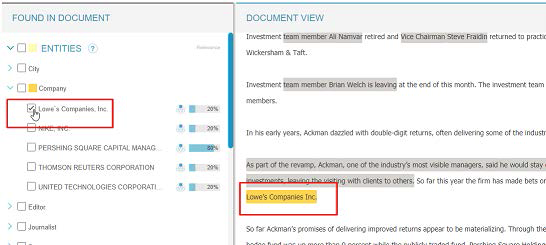Powered by Intelligent Tagging metadata tagging and a friendly user interface, the Intelligent Tagging Demo makes it easy to instantly tag any text, PDF, or XML input. Use the Demo to compare free and premium tagging results. Tagging results are organized and displayed for easy access. You can also upload existing Intelligent Tagging output RDF files to view the metadata in the same user-friendly, visual format.
This Read Me file describes:
How to use the Demo Tool to Tag Documents.
Which Processing Parameters you can define and which parameters are automatically applied.
How the Demo Tool displays the tagging output and how to drill down on individual tags.
Tagging Documents
To trigger Intelligent Tagging with the demo tool:
- Select tagging parameters.
- Enter text, or upload or drag-and drop one or multiple text, PDF, or XML files.
- Optionally, upload additional files.
- Click Tag it.
Alternatively: Upload one or more Intelligent Tagging RDF output files and click View. The RDF input is not further processed in any way. The RDF content is simply displayed in the user-friendly format.
Note: If you enter text when Document Type: News is selected, an XML template is displayed, making it simple to submit text in the format that returns the best tagging results. It is not mandatory to submit text in XML format. You may delete the XML template and enter or paste text for tagging.
The Processing Parameters
The tagging output is determined by the following user-defined options.
Document Type: News - triggers optimized tagging for news stories.
Document Type: Research - triggers optimized tagging for research reports.
Show Free Results - files are tagged as they would be by free Open Calais.
Show Premium Results - triggers premium tagging capabilities.
When Show Free Results is selected, the following input headers are used:
| Header | Description |
| Content-Type | Triggers optimized tagging for the specified input format. The value, text/raw or text/xml is automatically set according to the format of the input. |
| x-calais-contentClass | Triggers optimized tagging for the specified document type. Note that free Open Calais supports the News content class only. So when Show Free Results is selected, the contentClass value is automatically set to News. |
When Show Premium Results is selected, the following input headers are used:
| Header | Description |
| Content-Type | Triggers optimized tagging for the specified input format. The value -- text/raw , text/xml, or application/pdf -- is automatically set, depending on the format of the input. Note: If you are working in Internet Explorer, a PDF viewer must be installed on the client machine to enable tagging a PDF file. Also note that the PDF files must contain text objects. The tagging mechanism does not extract text from images in PDF files. |
| x-calais-contentClass | Triggers optimized tagging for the specified document type. In the Demo user interface, select Document Type News or Research to set this header value to “news” or “research.” |
| x-calais-SuppressSocialTagsFin | Excludes from the RDF output specific generic social tags that do not add value when tagging financial documents. |
| x-calais-pdftagzone | Extends tagging to tables in PDF files. (This header is triggered only for pdf files, and when the contentClass is research.) |
x-calais-EnableTickerExtraction |
Adds to the RDF output, company extractions based on ticker mentions in the text. |
x-calais-useSlugline |
Triggers classification of documents using Reuters sluglines. The tagging output may include slugline tags. |
Learn more about the Intelligent Tagging input headers.
For details about obtaining a premium license, please go to this page and click Request Product Details.
View the tagging results - Drill down on individual tags:
In the Found in Document pane, select an extracted entity to highlight the related text strings in the Document View.
Hover over an entity (in the Found in Document pane or in the Document View pane) to view the tag attributes:
In the Found in Document pane, click an entity's PermID icon ![]() to view linked data on PermID.org.
to view linked data on PermID.org.
Click View RDF to view the underlying RDF output file.
If you uploaded multiple documents for tagging, select a particular file from the popup menu at the top of the tagging results page. Or use the Previous and Next buttons.




